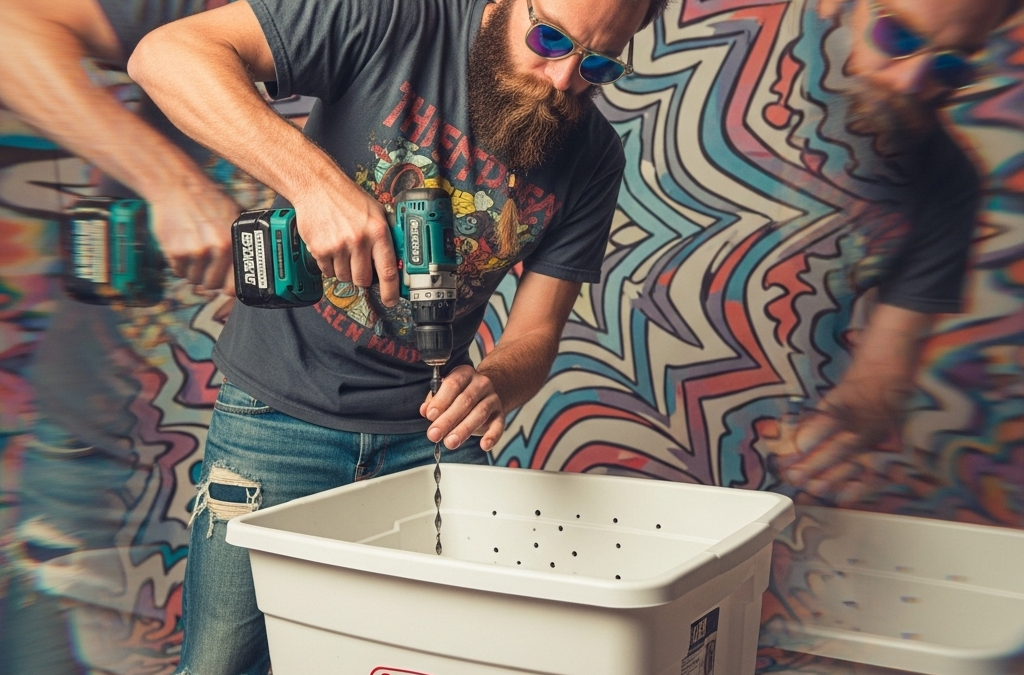The Ultimate Guide to Monotub Design: Mastering Fresh Air Exchange
If you’re passionate about growing mushrooms at home, you’ve probably heard about the monotub method. But do you know why it works so well, or how its design creates the perfect environment for your mushrooms to thrive? In this comprehensive guide, we’ll break down the science of monotub cultivation, explain the crucial role of fresh air exchange (FAE), and show you why building your own monotub is not just cost-effective—it’s the best way to learn and succeed as a cultivator.
What is a Monotub?
A monotub is a simple, self-contained mushroom cultivation chamber made from a large plastic bin—often a Sterilite or similar storage container—with strategically placed holes for air exchange. Unlike more complex setups, the monotub is designed to create a controlled microclimate that balances humidity, airflow, and contamination control. This makes it the go-to method for home growers seeking reliable, high-yield harvests without breaking the bank.
Why the Monotub Works: The Science Behind the Design
At first glance, a monotub might look like just a plastic box with some holes poked in it. But every aspect of its design serves a specific purpose:
-
The enclosed bin maintains humidity and provides a physical barrier.
-
Air exchange holes balance oxygen and CO₂, preventing staleness and mold.
-
Filtered ports reduce contamination while allowing gas exchange.
-
A large substrate volume supports bigger yields and a more stable microclimate.
-
A transparent lid allows light for pinning and easy monitoring.
The monotub’s enclosed design helps maintain high humidity, which is essential for mushroom fruiting and prevents the substrate from drying out. The transparent lid allows light to reach the mushrooms, supporting their natural growth cycles while letting you monitor progress without frequent disturbance.
The Critical Role of Fresh Air Exchange (FAE)
Fresh air exchange (FAE) is the cornerstone of healthy mushroom growth. Mycelium—the living fungal network that produces mushrooms—requires oxygen to metabolize nutrients and releases carbon dioxide (CO₂) as a byproduct. If CO₂ builds up inside your growing chamber, your mushrooms may develop long, stringy stems, small caps, or even stop growing altogether.
FAE is not just about poking holes and hoping for the best. It’s about engineering a passive airflow system that keeps oxygen levels high and CO₂ levels low, all while maintaining the humidity mushrooms need to thrive.
Monotub Airflow Dynamics: How CO₂ and Oxygen Move
Let’s get into the real science of airflow in a monotub, because understanding this is what separates successful cultivators from those who just follow instructions.
How Air Moves in a Monotub:
-
Side holes near the substrate: As your mycelium grows, it produces CO₂, which is heavier than air and settles near the bottom of the tub. The holes placed low on the sides, right at substrate level, allow this CO₂ to escape efficiently.
-
Upper holes on the ends: When CO₂ exits through the lower holes, it creates a slight negative pressure inside the tub. This negative pressure draws in fresh, oxygen-rich air through the upper holes, which are usually positioned on the short ends of the tub, above the substrate.
-
Passive airflow cycle: This setup creates a gentle, continuous airflow: CO₂ out the sides, fresh air in from above—no fans or fancy equipment needed.
Why This Matters:
-
Balanced air exchange ensures mushrooms get the oxygen they need and excess CO₂ is vented away.
-
The monotub’s enclosed design keeps humidity high, but the filtered holes prevent it from getting too wet or too dry.
-
Polyfill or micropore tape over the holes acts as a barrier, letting air move but keeping out unwanted spores and bacteria.
Understanding this airflow dynamic is crucial. Too little FAE, and your mushrooms will suffocate. Too much, and you risk drying out the substrate or introducing contaminants. The monotub strikes the perfect balance—when built and managed correctly.
The Self-Contained Microclimate Advantage
A well-designed monotub is more than just a growing container—it’s a microclimate in a box. You control the substrate, the moisture, the airflow, and the light. This self-sufficiency means:
-
Less maintenance: No need to constantly fan or mist (except maybe during fruiting).
-
Consistent results: The environment stays stable, leading to healthier, more reliable flushes.
-
Scalability: Want more mushrooms? Just add more tubs—each one is its own ecosystem.
This is why monotubs are so popular among both beginners and experienced growers. They’re customizable, scalable, and cost-effective.
DIY Monotub: Why You Should Build Your Own
With the rise of mushroom cultivation, the market is now flooded with “automated monotubs” and high-priced kits promising effortless results. But here’s the truth: you don’t need them. In fact, building your own monotub is not only more affordable—it’s the best way to learn the fundamentals of mushroom cultivation.
Why Build Your Own Monotub?
-
Cost-effective: Automated monotubs are expensive and often unnecessary for most growers. A simple Sterilite tub from Walmart, a drill, and some polyfill or micropore tape are all you need.
-
Contamination risk: Over-automation can disrupt the delicate balance of airflow and humidity, making your tub more susceptible to molds and bacteria, which can quickly ruin your crop.
-
Learning experience: Building your own monotub teaches you the fundamentals of environmental control. You’ll understand how humidity, airflow, and substrate interact, making you a better cultivator in the long run.
______________________________________
How to Build a Monotub
Materials needed:
-
1 large clear plastic tub (Sterilite, 54–66 qt recommended)
-
Drill with hole saw (1–2″ diameter)
-
Polyfill or micropore tape
Step-by-Step:
-
-
Long sides (lengthwise):
-
Option A: 4 holes per side using a 1″ hole saw
-
Option B: 2–3 holes per side using a 2″ hole saw
-
All should be placed about 4 inches from the bottom—right at or just above substrate level.
-
-
Short sides (width-wise):
-
Option A: 2–3 holes using a 1″ hole saw
-
Option B: 1–2 holes using a 2″ hole saw
These should go near the top, about 2 inches below the lid.
Mark Your Holes
Note: Hole size and placement can be dialed in based on the species you’re growing. Some require more or less FAE (fresh air exchange), so don’t be afraid to experiment.
-
-
-
Drill the Holes
-
Use a hole saw or step bit.
-
Smooth out any rough edges to prevent tearing filters.
-
-
Add Filters
-
Stuff the holes with polyfill or seal with micropore tape.
-
These allow gas exchange while keeping contaminants out.
-
-
Done
-
Your tub is now built and ready for substrate and spawn—handled separately.
-
Warning: The Pitfalls of Automated Monotubs
With the growing popularity of mushroom cultivation, many companies now offer “automated monotub” systems with built-in fans, humidifiers, and digital controls. While these may sound appealing, they come with significant drawbacks.
High Prices:
Automated monotubs can cost several times more than a DIY setup. You’re paying for bells and whistles you likely don’t need, especially as a beginner.
Increased Contamination Risk:
Automation often introduces too much humidity or dries out the substrate, disrupting the delicate balance mushrooms require. Fans and misting systems can also blow contaminants directly onto your substrate, leading to mold and bacterial outbreaks.
Less Control, Less Learning:
Relying on automation means you miss out on learning the fundamentals of environmental control. If something goes wrong, you may not know how to fix it.
Our Advice:
Skip the expensive automated kits. Head to your nearest Walmart or hardware store, buy a Sterilite tub, and drill the holes yourself. You’ll save money, gain valuable hands-on experience, and set yourself up for bigger, healthier harvests.
Conclusion: Take Control of Your Grow
The monotub method is more than just a set of instructions—it’s a science-backed approach to creating the perfect environment for mushrooms. By understanding the dynamics of fresh air exchange, humidity, and contamination control, you’ll be empowered to troubleshoot, optimize, and innovate your grows.
Don’t fall for overpriced automated systems. Building your own monotub is easy, affordable, and the best way to learn the art and science of mushroom cultivation. With a simple Sterilite tub, a drill, and a little know-how, you can create a thriving microclimate that produces healthy, abundant mushrooms—again and again.
Ready to get started? Buy your own tub, drill those holes, and watch your mushrooms flourish. Happy growing.
Keywords: monotub mushroom cultivation, DIY monotub, fresh air exchange, FAE, mushroom growing, contamination prevention, automated monotub warning, how to build a monotub, mushroom cultivation tips
If you found this guide useful, share it with fellow growers and leave a comment below with your monotub experiences or questions!

